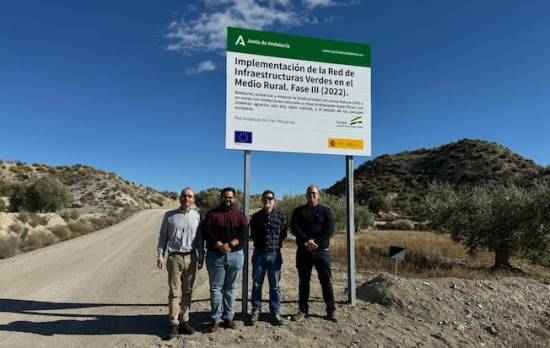
Through the project «Implementation of the priority network of green infrastructure in rural areas», the Regional Ministry of Sustainability, Environment and Blue Economy is investing in works to improve livestock trails throughout the province of Almeria. The territorial delegate, Manuel de la Torre, and the mayor of Zurgena, Domingo Trabalón, have visited the development of the adaptation and improvement works on the «Vereda de Los Vélez» and the «Vereda de la Fuente del Peral», in the municipality of Zurgena.
The Sustainability delegate explained that «the livestock trails are public domain assets and the Andalusian Regional Government is working to defend them as they are very useful for society». De la Torre highlighted the fact that «in the territorial Delegation there is a specific department dedicated to livestock trails which, with effort and dedication, is responsible for the demarcation of these trails. In addition, it guarantees their territorial integrity, processes requests for occupation, for example, due to crossings with linear infrastructures, and promotes projects such as this one for the adaptation of the livestock track, which includes the improvement of the road surface and masonry work.
De la Torre argued that «we have acted and continue to act throughout the provincial network: we have invested more than 125,000 euros in Zurgena, and when we finish this phase of the project in 2025 we will have worked in 49 municipalities, and always with the support of the town councils, whose collaboration I would like to highlight and thank».

The Mayor of Zurgena, Domingo Trabalón, thanked the Andalusian Regional Government for «this investment reinforces our natural heritage. Zurgena is committed to sustainability, to our environment and to the possibilities for development that our landscape offers us». This municipality,» added Trabalón, «recently joined the Network of Green and Sustainable Cities of Andalusia (REVERSA) promoted by the Regional Ministry, because we are convinced that towns must work along these lines.
Livestock trails are paths that have their origins in the historical transhumance of livestock between winter and summer pastures. They constitute a large territorial network with multiple functions beyond livestock: they are an essential element in land use planning, favour landscape diversification, promote biodiversity by enabling the genetic exchange of plant and animal species, and allow the development of leisure activities compatible with respect for the conservation of the natural environment.